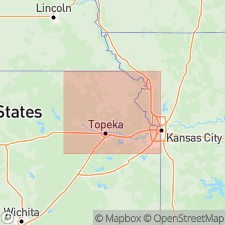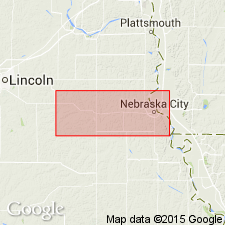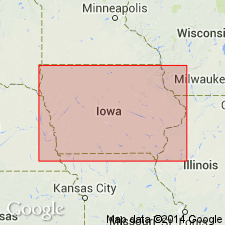
- Usage in publication:
-
- Friedrich shale
- Modifications:
-
- Revised
- AAPG geologic province:
-
- Cherokee basin
Summary:
Friedrich shale of Wabaunsee group. Underlies Jim Creek limestone [true] and overlies Grandhaven limestone. Age is Late Pennsylvanian (Virgil).
Source: US geologic names lexicon (USGS Bull. 896, p. 781); GNC KS-NE Pennsylvanian Corr. Chart, sheet 2, Oct. 1936.

- Usage in publication:
-
- Friedrich shale
- Modifications:
-
- Principal reference
- AAPG geologic province:
-
- Cherokee basin
Summary:
Pg. 49, 238. Friedrich shale of Wabaunsee group. Friedrich shale is here proposed to include clayey and sandy beds that overlie Grandhaven limestone and underlie Jim Creek limestone. The unweathered shale is chiefly bluish gray, but it commonly weathers yellowish or brownish. Locally there is sandstone in upper part, and in southern part of Greenwood County, eastern Kansas, a thin coal bed near top. Average thickness 15+/- feet.
Type locality: Friedrich Creek, in sec. 6, T. 22 S., R. 11 E., Greenwood Co., eastern KS.
Source: US geologic names lexicon (USGS Bull. 896, p. 781); GNC KS-NE Pennsylvanian Corr. Chart, sheet 2, Oct. 1936.

- Usage in publication:
-
- Friedrich shale formation
- Modifications:
-
- Revised
- AAPG geologic province:
-
- Nemaha anticline
Summary:
Pg. 9. Friedrich shale formation. In Nebraska, formation includes (ascending) Minersville shale, Palmyra limestone, and Otoe shale member (all new). Age is Late Pennsylvanian (Virgilian).
Source: US geologic names lexicon (USGS Bull. 1200, p. 1431-1432).

- Usage in publication:
-
- Friedrich shale member*
- Modifications:
-
- Revised
Summary:
Pg. 2274 (fig. 1), 2275. Friedrich shale member of Root shale. Rank reduced to member status in Root shale (new). Underlies Jim Creek limestone member; overlies Grandhaven limestone member of Stotler limestone (new). Age is Late Pennsylvanian (Virgilian).
Source: US geologic names lexicon (USGS Bull. 1200, p. 1431-1432).

- Usage in publication:
-
- Friedrich shale
- Modifications:
-
- Areal extent
- AAPG geologic province:
-
- Forest City basin
Summary:
Pg. 11, fig. 5. Friedrich shale of Wabaunsee group. Geographically extended into southwestern Iowa. Bluish gray to light gray, micaceous, and silty in upper part. Thickness 10 feet. Underlies Jim Creek limestone. Overlies Grandhaven limestone. Interval from lower part of Friedrich shale through Grandhaven limestone is exposed along bluffs of Missouri River and major tributaries in Fremont County extending from NW/4 sec. 1 to NW/4 sec. 13, T. 69 N., R. 43 W. Condra and Reed suggest that their Otoe shale, Palmyra limestone, and Minersville shale may occupy horizon of Friedrich shale. Age is Late Pennsylvanian (Virgilian).
Source: US geologic names lexicon (USGS Bull. 1200, p. 1431-1432).
For more information, please contact Nancy Stamm, Geologic Names Committee Secretary.
Asterisk (*) indicates published by U.S. Geological Survey authors.
"No current usage" (†) implies that a name has been abandoned or has fallen into disuse. Former usage and, if known, replacement name given in parentheses ( ).
Slash (/) indicates name conflicts with nomenclatural guidelines (CSN, 1933; ACSN, 1961, 1970; NACSN, 1983, 2005, 2021). May be explained within brackets ([ ]).

